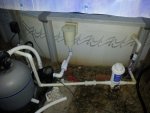Yes, in order to realize the efficiency gain with larger pipe, you have to reduce the pump run time. Otherwise, if you keep the run time the same, you end up using more power.
But if your next question is going to be, how much less should I run the pump, then that is more difficult to answer. Theoretically, a plumbing system with higher flow rate should need less run time to clean a pool than one with a slower flow rate. However, there have been
studies that show a typical pool only needs 3-4 hours of run time no mater the size of the pump or the size of the plumbing. However, they do recommend using larger pipe for better flow rates but they don't correlate this with less run time. If the study is correct about run time, that would mean you are better off with small high head loss plumbing but that seems counter intuitive. However, a smaller pump will always be more efficient so that is always a good idea.
My main point is that things are not always black and white. It really is going to depend on how you end up running the pump and if you can actually lower run time. Chances are you could probably reduce pump run time with your current setup and save energy costs and you might find out that to keep the pool the same cleanliness the run times are about the same with the two sets of plumbing.
This is why I generally do not recommend changing pipe size for at least the underground pipe because that can be quite expensive and you may never recoup the costs. However, if you are changing pumps anyway, then up sizing the pad plumbing is not such a big deal and would probably have at least some benefit especially on the suction side of the plumbing.
For your situation, I would suggest that you leave things as they are because you will probably never recoup the cost of the changes. Second, I would suggest experimenting with run time and see how low you can go.
As an example, I have a 20k pool with a 1/2 HP pump and during the heat of the summer I run my pump only 4 hours per day (~2 hrs high speed and ~ 2 hrs on low speed). This is less than 1/2 turnover per day and it keeps the pool chlorinated properly and as clean as I need it.



